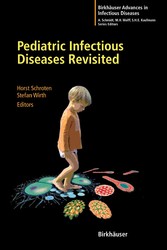Suchen und Finden
Contents
6
List of contributors
8
Preface
10
Glossary
11
Global control of infectious diseases by vaccination programs
15
Abstract
15
Introduction
16
Immunization policies and strategies
19
Current status, remaining problems, and progress achieved
28
Brief updates on priority current, under-used and new vaccines
35
References
49
Abstract
56
Introduction
56
Potential impact of rotavirus vaccination on the mortality of children in developing countries
56
Burden of rotavirus disease
57
Epidemiology of rotavirus in young children
58
Characteristics of rotavirus important for vaccine development
60
Pathogenesis and clinical presentation
62
Immunity against rotavirus infection
62
Rotavirus vaccine development
64
Challenges to rotavirus vaccine development
71
References
74
Controversially discussed indications for immunization
83
Abstract
83
Introduction
83
Immunization is safe and one of the most effective disease prevention measures
84
Indications for the immunization of selected risk groups
95
Contraindications and false contraindications
103
References
105
Gonorrheal ophthalmia neonatorum: Historic impact of Credé’s eye prophylaxis
107
Abstract
107
The endangered eyesight
108
Carl Siegmund Franz Credé, introducer of the antiseptic eye prophylaxis with silver nitrate
108
“Prevention of Inflammatory eye disease in the newborn. Information from the Maternity Clinic Leipzig by Credé” [22]
110
Ludwig Sigesmund Albert Neisser and insights into etiology and pathophysiology of gonorrhea at Credé’s time
115
Discussion of Credé’s activities and his “four publications with the same title”
117
Credé’s prophylaxis today
118
Some confusion about Carl Credé?
119
Addendum
120
References
124
Malnutrition and infection in industrialized countries
128
Abstract
128
Introduction
128
Pathophysiology of malnutrition
129
Immune dysfunction and malnutrition
132
Specific micronutrient deficiencies
135
Malnutrition syndromes of childhood
136
Chronic infection
142
References
145
Better education through improved health and nutrition: implications for early childhood development programs in developing countries
155
Abstract
155
Introduction
155
Health and nutrition problems in preschool children
156
Impact of health and nutrition on school readiness
156
Programmatic responses
174
Interventions: What works?
174
Health or education interventions: Targeting disease or symptoms?
178
Promoting equity through preschool health interventions
179
Conclusions
179
References
180
Early childhood caries and childhood periodontal diseases
187
Abstract
187
Introduction
187
Early childhood caries
188
Childhood periodontal diseases
194
References
203
Role of the blood-brain barrier and blood-CSF barrier in the pathogenesis of bacterial meningitis
208
Abstract
208
Introduction
208
Bacterial meningitis
209
The pathogenetic cascade
210
The blood-CNS barriers
212
Gateways into the brain
215
Experimental models for blood-CNS-barrier observations
219
Microbial translocation across the blood-CNS barrier
222
Interactions between bacteria and blood-CNS barrier cells
224
BBB disruption and pleocytosis
228
Immunological properties of the blood-CNS barrier
229
Conclusion
233
References
233
The molecular basis of paediatric malarial disease
247
Abstract
247
Introduction
247
Severe malaria in children compared to adults
249
How might P. falciparum cause this complex disease?
250
Metabolic acidosis in falciparum malaria
257
Neurological involvement in malaria
259
Red cell abnormalities and malaria
264
Potential therapies directed at disease mechanisms
265
References
267
Epidemiology and etiology of Kawasaki disease
281
Abstract
281
Introduction
281
Diagnostic criteria and diagnostic approach
282
Epidemiology
282
Pathology
289
Etiology
293
References
295
Helicobacter pylori infection in children
304
Abstract
304
Introduction
304
Epidemiology
305
Pathogenesis
305
Clinical presentation
306
Helicobacter pylori and abdominal pain
308
H. pylori and gastroesophageal reflux disease
309
Extragastric manifestations of H. pylori infection in children
309
Refractory iron-deficiency and H. pylori infection
309
Idiopathic thrombocytopenia and H. pylori infection
310
Investigations
311
Antibiotic resistance
315
Treatment
315
Conclusion
316
References
316
Human metapneumovirus infection
323
Abstract
323
Background
323
Epidemiology
326
Pathogenesis and host response
329
Diagnosis
336
Clinical characteristics
338
Vaccination
341
Conclusions
344
References
344
Avian influenza viruses: a severe threat of a pandemic in children?
351
Abstract
351
Introduction
351
Influenza virus
352
Pandemic influenza
352
Avian influenza virus
353
Spread of H5N1 influenza in avian populations
354
Epidemiology and clinical features of avian influenza in children
355
Clinical presentation and outcome
357
Diagnosis
359
Treatment
360
Vaccines
361
Summary
363
References
363
Human papillomavirus infections in children
370
Abstract
370
Introduction
370
Biology of the HPV
371
Demographics and epidemiology
372
Natural history
373
Diagnosis of warts
373
Defining wart types
373
Host response (Tab. 3)
379
Host side effects of note
381
Conditions with excessive numbers of warts
382
Malignant conversion of HPV
384
Role of HPV in non-wart skin conditions
385
Differential diagnosis
385
Genital HPV infection
387
Conclusions
389
References
389
New treatments for hepatitis B and C in children and adolescents
396
Abstract
396
Hepatitis B
397
Hepatitis C
403
References
407
Invasive fungal infections in children: advances and perspectives
410
Abstract
410
Introduction
410
Host biology: Aspects unique to pediatric patients
411
Pediatric populations at risk for invasive infections
412
Epidemiology and presentation of invasive fungal infections in pediatric patients
412
Recent advances in early diagnosis and preemptive therapy
421
Pediatric pharmacology of established antifungal agents
422
New agents for treatment and prevention and their pediatric development
436
Selected management issues of invasive fungal infections
447
Conclusions
449
References
450
Pediatric aspects of bioterrorism
478
Abstract
478
Introduction
478
Anthrax
481
Smallpox
485
References
488
Pediatric infectious diseases – Quo vadis 2015?
490
Abstract
490
Introduction
490
Current activities of the pediatric infectious disease specialist
491
New developments for the specialists in pediatric infectious diseases
494
Conclusions
499
References
500
Index
502
Alle Preise verstehen sich inklusive der gesetzlichen MwSt.




















